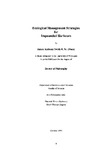Ecological Management Strategies for Impounded Harbours
| dc.contributor.author | Smith, James Anthony | |
| dc.contributor.other | School of Geography, Earth and Environmental Sciences | en_US |
| dc.date.accessioned | 2013-10-28T11:52:57Z | |
| dc.date.available | 2013-10-28T11:52:57Z | |
| dc.date.issued | 1995 | |
| dc.identifier | NOT AVAILABLE | en_US |
| dc.identifier.uri | http://hdl.handle.net/10026.1/2412 | |
| dc.description.abstract |
Long-term physical, chemical and biological monitoring (May 1990 to November 1994) was conducted in order to quantify water and sediment quality changes arising from the impoundment of Sutton Harbour, Plymouth (UK). Spore tracer studies revealed that 95 % water renewal times increased from 45 h to 72 h after impoundment. Semi-diurnal (tidal) salinity variations of circa 5 x10ˉ³ were observed, revealing a mechanism which shunts contaminated estuarine water into the harbour during flood tides. Salinity typically varied from 17 x 10ˉ³ to 34 x 10ˉ³ seasonally, and exhibited strong inverse correlations with total oxidised nitrogen and orthophosphate, demonstrating the riverine source of dissolved nutrients. These varied seasonally in concentration by 2 to 3 orders of magnitude. Impoundment restricted the flux of riverborne nutrients but greater retention of brackish bottom waters produced a stronger concentration gradient, resulting in possible nutrient storage by diffusion into the porewaters. Sewage outfalls and sediments were the main sources of ammonium. Following impoundment, the evidence suggests that a balance between nutrients from reduced external (riverine) fluxes and increased internal (porewater) fluxes has developed. Phytoplankton blooms were regular but short-lived features in summer, and continued after impoundment. Sewage contamination, with faecal coliform bacteria occasionally exceeding 30,000 cfu 100 mtˉ¹, improved unequivocally after impoundment, but stricter controls on internal sources are required. The permanently anoxic harbour sediments, consisting mainly of silt, contained Cd (1.8 µg gˉ¹), Cu (160 µg gˉ¹), Hg (1.2 µg gˉ¹), Pb (200 µg gˉ¹) and Zn (290 µg gˉ¹) in the <63 µm fraction. Sedimentary Cu, Pb and Zn concentrations increased during the monitoring period. The benthic macrofauna consists mainly of polychaete worms, with species diversity decreasing during construction, and then attaining a new, impoverished equilibrium after impoundment. Multivariate analysis revealed changes in community structure involving loss of sensitive taxa and appearance of opportunists. The ecological impact of impoundment was minimal, in that the harbour ecosystem was able to withstand the imposed environmental stresses. The management strategy adopted will ensure that water and sediment quality are maintained in Sutton Harbour; recommendations equally applicable to future harbour impoundment projects. | en_US |
| dc.description.sponsorship | National Rivers Authority South Western Region | en_US |
| dc.language.iso | en | en_US |
| dc.publisher | University of Plymouth | en_US |
| dc.title | Ecological Management Strategies for Impounded Harbours | en_US |
| dc.type | Thesis | |
| dc.identifier.doi | http://dx.doi.org/10.24382/3785 | |
| dc.identifier.doi | http://dx.doi.org/10.24382/3785 |
Files in this item
This item appears in the following Collection(s)
-
01 Research Theses Main Collection
Research Theses Main


